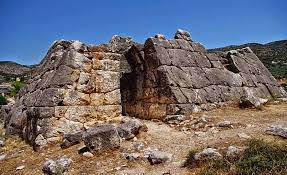
The two pyramids in Helinikon were first discovered in the 2nd century BC. mentioned by the Greek geographer Pausanias. Today there is only one, and what particularly attracts the attention of researchers is that it is still unknown how old it is, nor what its purpose was.
Usually when we talk about pyramids we think of those in Egypt, Mexico or Peru, although their presence has been recorded in other parts of the world. One of them is also found in Europe, more precisely in Argolis and what is even more interesting is not a recent discovery at all because the Greek geographer and traveler Pausanias wrote about the existence of not one, but two pyramids in Helinikon as early as the 2nd century BC.
Namely, in his Description of Greece, he talks about two buildings with a pyramidal structure, one of which is located twenty kilometers southwest of the one that still exists today. His opinion was that soldiers who died in the legendary battle fought in Argos were most likely buried there:
“On the road from Argos to Epidaurus, on the right, there is a building similar to a pyramid, on which Argive shields are carved in relief. Here the battle for the throne took place between Praetos and Akrisius; and the duel, they say, ended in a draw and a reconciliation, because neither neither could win. A common grave was built for those who fell, since they were fellow citizens and relatives.”

Modern researchers doubt this hypothesis, primarily because it is a small structure of about 7 m x 9 m with walls rising at an angle of 60 degrees and whose height does not exceed 3.5 m. The first excavations were undertaken by the German archaeologist Theodor Wiegand at the beginning of the 20th century, and his work was continued by researchers from the American School of Archeology in Athens and concluded that the building was a kind of watchtower.
Controversies related to estimated age
More recent research began in the 1990s under the direction of Greek archaeologist Ioannis Lirikas, who estimates that there are at least 20 other similar structures in Greece. He then discovered in their interior pottery from different periods, lamps, glasses, bowls, plates and large pitos – egg-shaped vessels used to store grains and oil. All the findings were so mixed that it was not possible to determine their age.

In addition, the analyzes that Lirikas and his team conducted inside and around the building using the thermoluminescence technique failed to convince other scientists of the accuracy of the data. First of all, the inner blocks were selected for sampling, seven of which were dated to the period between 2500 and 2000 BC, while the estimated age of the two ceramic vessels was between 3000 and 660 BC. This is considered an extremely wide range that suggests that is perhaps even older than the Great Pyramids, but it is also impossible to say with certainty when exactly it was built.

Leave a comment